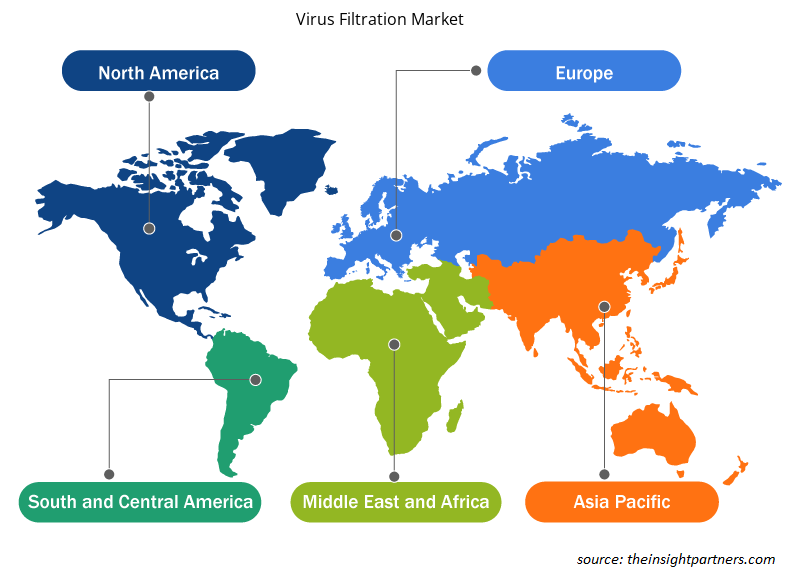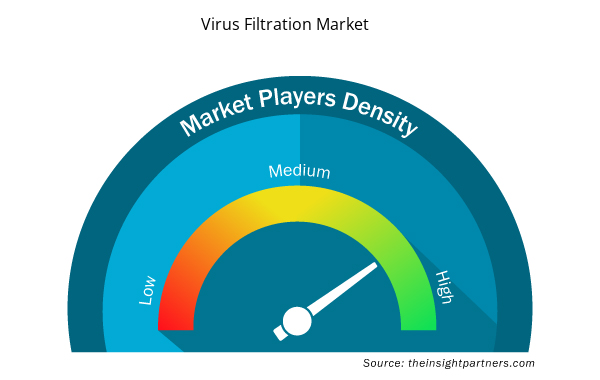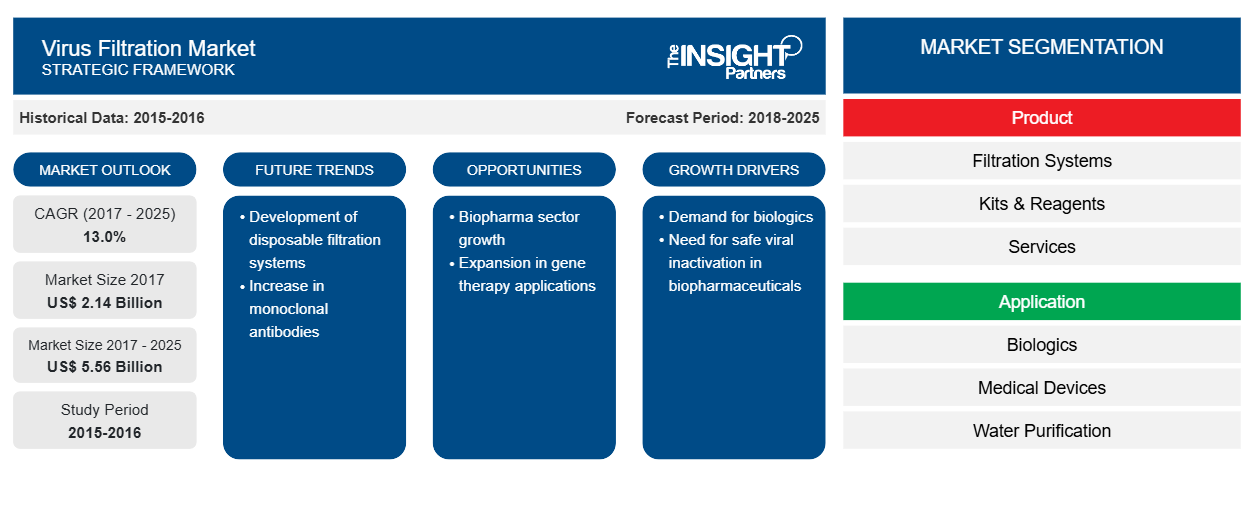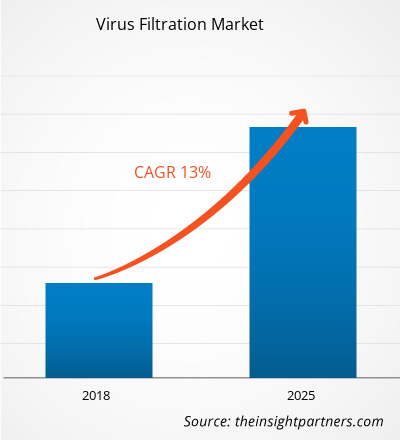病毒过滤是一种有效的病毒清除技术,可应用于多个生物制剂领域。全球病毒过滤市场规模预计将从 2017 年的 21.394 亿美元增至 2025 年的 55.554 亿美元。预计 2018 年至 2025 年期间,该市场的复合年增长率为 13.0%。
近年来,由于慢性病发病率上升,生物制药行业经历了快速增长。与小分子不同,生物药物是使用动物、植物和合成来源的混合物配制而成的。一些生物治疗产品是使用哺乳动物细胞系或人类血浆生产的。所有这些都使污染的可能性增加了十倍。这些产品中被病毒污染的风险是危险的;因此,监管机构要求制造商评估病毒污染的风险并采取必要措施减轻风险。病毒过滤市场广泛应用于生物制药产品的净化,以避免风险并遵守监管机构制定的安全规范。制药公司加大了对病毒过滤的投资,因为它将在生物制药产品的安全中发挥巨大作用。
在实验室中,病毒很容易污染空气、水和测试样本。因此,病毒过滤的需求势在必行。连续生物处理在 mAb 生产中迅速发展,具有潜在优势,例如更小的设施占地面积、更低的投资成本、灵活性和工艺经济性。连续下游处理依赖于此过程中的病毒过滤。病毒过滤市场方法使用膜屏障来保留病毒颗粒以维持无污染环境。它是一种强大、可靠的病毒清除技术,被各种终端用户垂直行业使用。全球病毒过滤市场的增长受到生物制剂和生物制药产品制造增加、监管规范严格以及研发和外包活动投资增加的推动。
驱动程序
制药和生物技术行业快速增长
过去几年,制药行业发展迅猛。对新药、先进疗法、快速数字化和不断变化的法规的需求对制造商和合同研究组织 (CRO)提出了医疗保健挑战。根据世界卫生组织 (WHO) 的数据,全球人口每年增长 1.24%,导致对药品和药物的需求过剩。截至 2017 年,制药行业比之前的估计增长了 30%,保持了其在五大行业中的地位,并增加了全球经济价值。许多药品制造商生产价格合理的药品,以满足发展中经济体中等收入人群的需求。每种新药配方都伴随着强制性的病毒清除测试,以评估已知或未知病毒痕迹的消除情况。
严格的监管框架
食品药品管理局 (FDA)、欧洲药品管理局 (EMA) 等主要监管机构持续跟踪和监控制药和生物技术行业的发展。制造商遵守最新法规,遵循现行良好生产规范 (GMP) 和良好实验室规范 (GLP)。任何偏离规定方案的行为都可能导致相关制造商或外包组织的临床试验终止。美国 FDA 发布了针对制药公司的指南,涉及对源自人类细胞系或动物源的产品进行病毒安全性评估。医疗保健管理机构执行的此类严格法规要求在药物开发过程中进行病毒清除测试。
限制
病毒清除替代技术的可用性
外来病毒因子在生物药物生产中具有固有的污染风险。监管机构已经提前解决了这些问题。病毒过滤的成功取决于对合适方法的偏好。合适的方法取决于各种生物和临床因素。一些突出的方法包括添加低 pH 缓冲液、保持温度和洗涤剂处理,以灭活生物处理溶液中的病毒。在这些可行的方法中,只有当溶液无法通过高压灭菌消毒时才会部署病毒过滤技术。这停止了对过滤的需求,从而阻碍了全球病毒过滤市场的增长。
定制此报告以满足您的需求
您可以免费定制任何报告,包括本报告的部分内容、国家级分析、Excel 数据包,以及为初创企业和大学提供优惠和折扣
- 获取此报告的关键市场趋势。这个免费样品将包括数据分析,从市场趋势到估计和预测。
市场细分
按产品
生物制药工艺中的高过滤程度支撑了分段优势
根据产品,全球病毒过滤市场分为过滤系统、试剂盒和试剂、服务和其他。其中,试剂盒和试剂部分在 2017 年占据了显著的市场份额。在实验室规模测试和生物制药制造过程中,试剂盒和试剂可有效去除重组蛋白、单克隆抗体和组织提取物中的病毒。即用型商用试剂盒专门用于病毒 DNA 纯化、qPCR 和免疫学应用。这些试剂盒的膜旨在从水溶液和基质中去除特定大小的病毒。值得注意的是,这些试剂盒和试剂简单易用且安全,几乎不需要专业知识和简单的操作规程。
过滤系统是 2017 年全球病毒过滤市场的第二大市场。这些过滤系统通常用于去除细小病毒或其他含有蛋白质外壳的特定类型病毒。过滤系统优于其他病毒去除技术,因为它们不会使样本的蛋白质变性。此外,这些系统有助于提高总吞吐量并降低总体病毒过滤成本。因此,它们在医疗器械制造和制定研究程序中被广泛采用。
按应用
进行多项临床试验的制药公司推动了该领域的市场份额
根据应用,病毒过滤市场领域分为生物制剂、医疗设备、水净化和空气净化。其中,生物制剂部门在 2017 年占据市场主导地位,收入份额最大。在生物治疗疗法中,一些物质要么在体内自然存在,要么在实验室中培养。这些过程涉及导致病毒污染的几种情况。因此,在将测试结果提交给监管机构之前,通过病毒清除测试来评估与血浆衍生疗法相关的病毒安全性。所有进行临床试验测试的制药公司和 CRO 预计将在未来几年内促进相关部门的增长。
预计整个预测期内,水净化部分将大幅扩张。水中的肠道病毒会对人类和动物造成严重的健康危害。它们对水生环境具有很强的抵抗力,并会造成水污染。过滤是一种经济有效且清晰的方法,可产生出色的消毒效果并防止病毒在水中滋生。从含有大量水的培养基中纯化病毒抗原也变得至关重要。从水中清除病毒体可获得最佳的疫苗接种效果。
区域市场
北美是病毒过滤最大的市场,其中美国占有最大的市场份额,其次是加拿大。生物制药和生物技术公司、主要市场参与者以及各种学术和研究机构都提高了对病毒过滤系统的需求,进一步刺激了北美全球病毒过滤市场的增长。
欧洲在全球病毒过滤市场中占有重要地位,预计由于政府和私人对生物制剂和药品研究的资助,欧洲将实现强劲增长率。此外,创新技术的推出可能是推动欧洲该市场增长的主要因素。德国是欧洲最大的生物技术中心,因为这里有大型生物技术公司、高科技研究实验室和大量研发资金。
欧洲和北美已经取得了许多进展。这可能是预测期内这些地区的市场表现良好的原因。
亚太地区研究中心和政府资金的增加推动了该地区市场的增长。政府机构提供补助金以增加年轻研究人员的参与度。
中东和非洲由三个主要国家组成:阿拉伯联合酋长国 (UAE)、沙特阿拉伯和南非。该地区的市场由多个研究机构开展的广泛研究项目以及基础设施和研究设施的可用性推动。政府对研发、医疗保健的举措以及技术先进的设备的可用性推动了病毒过滤市场的增长。南美洲和中美洲的病毒过滤市场由于最近的技术发展而增长。低成本优势和更高的工作效率是制造公司在南美建立基地的主要吸引力。
主要市场参与者:
- 默克集团(德国)
- Sartorius AG(德国)
- 丹纳赫(Pall Corporation)(美国)
- 赛默飞世尔科技公司(美国)
- 通用电气(美国)
- 查尔斯河(美国)
- 无锡药明康德新药开发有限公司 (中国)
- 龙沙(瑞士)
- 旭化成株式会社(日本)
- 洁净室(法国)
病毒过滤市场区域洞察
Insight Partners 的分析师已详尽解释了预测期内影响病毒过滤市场的区域趋势和因素。本节还讨论了北美、欧洲、亚太地区、中东和非洲以及南美和中美洲的病毒过滤市场细分和地理位置。

- 获取病毒过滤市场的区域特定数据
病毒过滤市场报告范围
| 报告属性 | 细节 |
|---|---|
| 2017年市场规模 | 21.4亿美元 |
| 2025 年市场规模 | 55.6亿美元 |
| 全球复合年增长率(2017 - 2025) | 13.0% |
| 史料 | 2015-2016 |
| 预测期 | 2018-2025 |
| 涵盖的领域 | 按产品
|
| 覆盖地区和国家 | 北美
|
| 市场领导者和主要公司简介 |
|
病毒过滤市场参与者密度:了解其对业务动态的影响
病毒过滤市场正在快速增长,这得益于最终用户需求的不断增长,这些需求源于消费者偏好的不断变化、技术进步以及对产品优势的认识不断提高等因素。随着需求的增加,企业正在扩大其产品范围,进行创新以满足消费者的需求,并利用新兴趋势,从而进一步推动市场增长。
市场参与者密度是指在特定市场或行业内运营的企业或公司的分布情况。它表明在给定市场空间中,相对于其规模或总市场价值,有多少竞争对手(市场参与者)存在。
在病毒过滤市场运营的主要公司有:
- 默克公司
- 赛多利斯公司
- 丹纳赫(颇尔公司)
- 赛默飞世尔科技公司
- 通用电气
免责声明:上面列出的公司没有按照任何特定顺序排列。

- 获取病毒过滤市场顶级关键参与者概述
主要进展:
- 2018 年 2 月:默克公司推出 Viresolve Barrier 胶囊过滤器,以降低生物反应器污染风险。这些胶囊可清除细胞培养基中的病毒、支原体和细菌。
- 2017 年 9 月
:
赛多利斯在哥廷根建立了一个新的设施中心,用于生产天平、超纯水系统和水分分析仪等实验室仪器。 - 2016 年 9 月:Pall 公司推出 Pegasus Prime 病毒清除过滤器,用于在关键制造工艺中捕获小病毒。
- 2016 年 4 月:Charles River Laboratories 收购了 WIL Research,后者是一家领先的安全评估、合同开发和制造服务提供商。
报告范围
全球病毒过滤市场研究报告提供了有关市场份额、规模、趋势和机会的详细见解。它简要介绍了影响市场波动的驱动因素和限制因素的作用。此外,还详细阐述了行业格局、市场概况和全球业务分析,以帮助确定未来的业务投资。随着他们最近的发展,主导市场参与者被重点介绍,并提到了产品发布、扩张和收购。
- 历史分析(2 年)、基准年、预测(7 年)及复合年增长率
- PEST 和 SWOT 分析
- 市场规模价值/数量 - 全球、区域、国家
- 行业和竞争格局
- Excel 数据集


- Bioremediation Technology and Services Market
- Adaptive Traffic Control System Market
- Legal Case Management Software Market
- Electronic Signature Software Market
- Medical Enzyme Technology Market
- Passport Reader Market
- Microcatheters Market
- Educational Furniture Market
- Ceramic Injection Molding Market
- Environmental Consulting Service Market

Report Coverage
Revenue forecast, Company Analysis, Industry landscape, Growth factors, and Trends

Segment Covered
This text is related
to segments covered.

Regional Scope
North America, Europe, Asia Pacific, Middle East & Africa, South & Central America

Country Scope
This text is related
to country scope.
常见问题
The growth of the Virus filtration in market is attributed to the rising application of Virus filtration, launch of new virus filtration system, adoption of inorganic strategies by market players and rising demand for virus filtration technologies in biotechnology and pharmaceuticals.
The services segment is anticipated to witness the fastest growth rate of 14.9% during the forecast period, 2018 to 2025.
In 2017, the kits & reagents segment held a largest market share of 54.4% of the virus filtration market, by product. This segment is also expected to dominate the market in 2025 owing to increasing demand for kits and reagents in biotechnology and pharmaceutical companies.
Trends and growth analysis reports related to Life Sciences : READ MORE..
The List of Companies
1. Merck KGaA
2. Sartorius AG
3. Danaher (Pall Corporation)
4. Thermo Fisher Scientific, Inc.
5. General Electric
6. Charles River
7. Wuxi Apptec
8. Lonza
9. Asahi Kesai Corporation
10. Clean Cells
The Insight Partners performs research in 4 major stages: Data Collection & Secondary Research, Primary Research, Data Analysis and Data Triangulation & Final Review.
- Data Collection and Secondary Research:
As a market research and consulting firm operating from a decade, we have published and advised several client across the globe. First step for any study will start with an assessment of currently available data and insights from existing reports. Further, historical and current market information is collected from Investor Presentations, Annual Reports, SEC Filings, etc., and other information related to company’s performance and market positioning are gathered from Paid Databases (Factiva, Hoovers, and Reuters) and various other publications available in public domain.
Several associations trade associates, technical forums, institutes, societies and organization are accessed to gain technical as well as market related insights through their publications such as research papers, blogs and press releases related to the studies are referred to get cues about the market. Further, white papers, journals, magazines, and other news articles published in last 3 years are scrutinized and analyzed to understand the current market trends.
- Primary Research:
The primarily interview analysis comprise of data obtained from industry participants interview and answers to survey questions gathered by in-house primary team.
For primary research, interviews are conducted with industry experts/CEOs/Marketing Managers/VPs/Subject Matter Experts from both demand and supply side to get a 360-degree view of the market. The primary team conducts several interviews based on the complexity of the markets to understand the various market trends and dynamics which makes research more credible and precise.
A typical research interview fulfils the following functions:
- Provides first-hand information on the market size, market trends, growth trends, competitive landscape, and outlook
- Validates and strengthens in-house secondary research findings
- Develops the analysis team’s expertise and market understanding
Primary research involves email interactions and telephone interviews for each market, category, segment, and sub-segment across geographies. The participants who typically take part in such a process include, but are not limited to:
- Industry participants: VPs, business development managers, market intelligence managers and national sales managers
- Outside experts: Valuation experts, research analysts and key opinion leaders specializing in the electronics and semiconductor industry.
Below is the breakup of our primary respondents by company, designation, and region:

Once we receive the confirmation from primary research sources or primary respondents, we finalize the base year market estimation and forecast the data as per the macroeconomic and microeconomic factors assessed during data collection.
- Data Analysis:
Once data is validated through both secondary as well as primary respondents, we finalize the market estimations by hypothesis formulation and factor analysis at regional and country level.
- Macro-Economic Factor Analysis:
We analyse macroeconomic indicators such the gross domestic product (GDP), increase in the demand for goods and services across industries, technological advancement, regional economic growth, governmental policies, the influence of COVID-19, PEST analysis, and other aspects. This analysis aids in setting benchmarks for various nations/regions and approximating market splits. Additionally, the general trend of the aforementioned components aid in determining the market's development possibilities.
- Country Level Data:
Various factors that are especially aligned to the country are taken into account to determine the market size for a certain area and country, including the presence of vendors, such as headquarters and offices, the country's GDP, demand patterns, and industry growth. To comprehend the market dynamics for the nation, a number of growth variables, inhibitors, application areas, and current market trends are researched. The aforementioned elements aid in determining the country's overall market's growth potential.
- Company Profile:
The “Table of Contents” is formulated by listing and analyzing more than 25 - 30 companies operating in the market ecosystem across geographies. However, we profile only 10 companies as a standard practice in our syndicate reports. These 10 companies comprise leading, emerging, and regional players. Nonetheless, our analysis is not restricted to the 10 listed companies, we also analyze other companies present in the market to develop a holistic view and understand the prevailing trends. The “Company Profiles” section in the report covers key facts, business description, products & services, financial information, SWOT analysis, and key developments. The financial information presented is extracted from the annual reports and official documents of the publicly listed companies. Upon collecting the information for the sections of respective companies, we verify them via various primary sources and then compile the data in respective company profiles. The company level information helps us in deriving the base number as well as in forecasting the market size.
- Developing Base Number:
Aggregation of sales statistics (2020-2022) and macro-economic factor, and other secondary and primary research insights are utilized to arrive at base number and related market shares for 2022. The data gaps are identified in this step and relevant market data is analyzed, collected from paid primary interviews or databases. On finalizing the base year market size, forecasts are developed on the basis of macro-economic, industry and market growth factors and company level analysis.
- Data Triangulation and Final Review:
The market findings and base year market size calculations are validated from supply as well as demand side. Demand side validations are based on macro-economic factor analysis and benchmarks for respective regions and countries. In case of supply side validations, revenues of major companies are estimated (in case not available) based on industry benchmark, approximate number of employees, product portfolio, and primary interviews revenues are gathered. Further revenue from target product/service segment is assessed to avoid overshooting of market statistics. In case of heavy deviations between supply and demand side values, all thes steps are repeated to achieve synchronization.
We follow an iterative model, wherein we share our research findings with Subject Matter Experts (SME’s) and Key Opinion Leaders (KOLs) until consensus view of the market is not formulated – this model negates any drastic deviation in the opinions of experts. Only validated and universally acceptable research findings are quoted in our reports.
We have important check points that we use to validate our research findings – which we call – data triangulation, where we validate the information, we generate from secondary sources with primary interviews and then we re-validate with our internal data bases and Subject matter experts. This comprehensive model enables us to deliver high quality, reliable data in shortest possible time.


 获取此报告的免费样本
获取此报告的免费样本